Page 278 of 494
driving, cold slippery conditions, mountain driving,
trailer towing, and many other situations.AUTOSTICK�OPERATION
By placing the gear selector lever one shift-level below
the DRIVE position, it can be moved from side to side.
This allows the driver to select a higher or lower range of
gears. Moving the gear selector lever to the Left (-)
triggers a downshift and to the Right (+) an upshift. The
gear position will display in the instrument cluster on the
transaxle range indicator.
NOTE:In Autostick�mode, the transaxle will only shift
up or down when the driver moves the gear selector
lever to the Right (+) or Left (-).
AutoStick�is deactivated when the lever is shifted from
the AutoStick (+/-) position into the DRIVE position.
AutoStick�Gear Selector Lever
276 STARTING AND OPERATING
Page 302 of 494

4) the cold tire inflation pressures for the front, rear
and spare tires.
Loading
The vehicle maximum load on the tire must not exceed
the load carrying capacity of the tire on your vehicle. You
will not exceed the tire’s load carrying capacity if you
adhere to the loading conditions, tire size, and cold tire
inflation pressures specified on the “Tire and Loading
Information” placard and in the “Vehicle Loading” sec-
tion of this manual.
NOTE:Under a maximum loaded vehicle condition,
gross axle weight ratings (GAWR’s) for the front and rear
axles must not be exceeded. For further information on
GAWR’s, vehicle loading, and trailer towing, refer to the
“Vehicle Loading” section of this manual.
To determine the maximum loading conditions of your
vehicle, locate the statement “The combined weight of
occupants and cargo should never exceed XXX kg or XXXlbs.” on the Tire and Loading Information placard. The
combined weight of occupants, cargo/luggage and
trailer tongue weight (if applicable) should never exceed
the weight referenced here.
Steps for Determining Correct Load Limit
1. Locate the statement “The combined weight of occu-
pants and cargo should never exceed XXX pounds” on
your vehicle’s placard.
2. Determine the combined weight of the driver and
passengers that will be riding in your vehicle.
3. Subtract the combined weight of the driver and pas-
sengers from XXX kilograms or XXX pounds.
4. The resulting figure equals the available amount of
cargo and luggage load capacity. For example, if “XXX”
amount equals 1400 lbs. and there will be five 150 lb.
300 STARTING AND OPERATING
Page 303 of 494

passengers in your vehicle, the amount of available cargo
and luggage load capacity is 650 lbs. (since 5 x 150 = 750,
and 1400 – 750 = 650 lbs.)
5. Determine the combined weight of luggage and cargo
being loaded on the vehicle. That weight may not safely
exceed the available cargo and luggage load capacity
calculated in Step 4.
6. If your vehicle will be towing a trailer, load from your
trailer will be transferred to your vehicle. Consult this
manual to determine how this reduces the available
cargo and luggage load capacity of your vehicle.NOTE:The following table shows examples on how to
calculate total load, cargo/luggage and towing capacities
of your vehicle with varying seating configurations and
number and size of occupants. This table is for illustra-
tion purposes only and may not be accurate for the
seating and load carry capacity of your vehicle.
NOTE:For the following example the combined weight
of occupants and cargo should never exceed 865 lbs.
(392 Kg).
STARTING AND OPERATING 301
5
Page 340 of 494
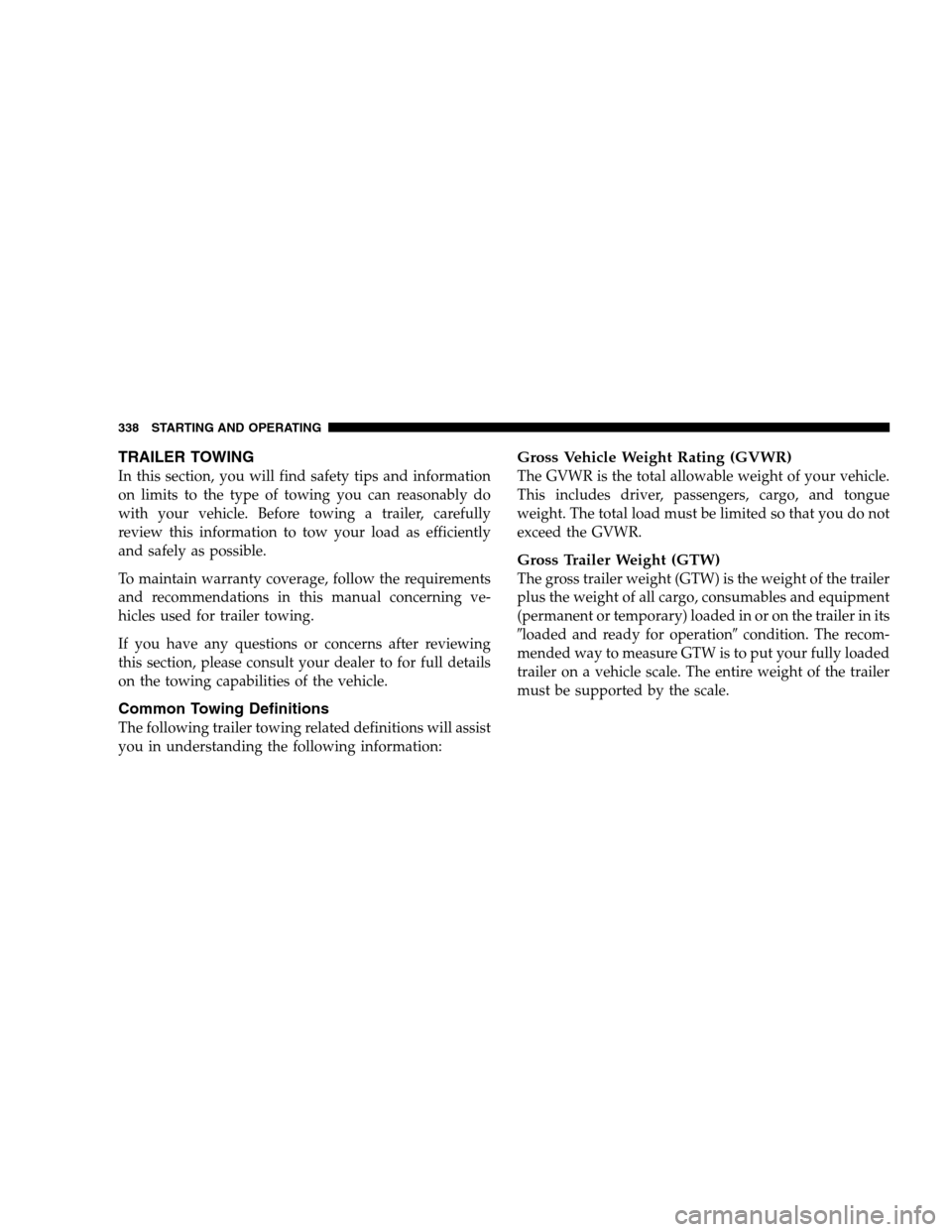
TRAILER TOWING
In this section, you will find safety tips and information
on limits to the type of towing you can reasonably do
with your vehicle. Before towing a trailer, carefully
review this information to tow your load as efficiently
and safely as possible.
To maintain warranty coverage, follow the requirements
and recommendations in this manual concerning ve-
hicles used for trailer towing.
If you have any questions or concerns after reviewing
this section, please consult your dealer to for full details
on the towing capabilities of the vehicle.
Common Towing Definitions
The following trailer towing related definitions will assist
you in understanding the following information:
Gross Vehicle Weight Rating (GVWR)
The GVWR is the total allowable weight of your vehicle.
This includes driver, passengers, cargo, and tongue
weight. The total load must be limited so that you do not
exceed the GVWR.
Gross Trailer Weight (GTW)
The gross trailer weight (GTW) is the weight of the trailer
plus the weight of all cargo, consumables and equipment
(permanent or temporary) loaded in or on the trailer in its
�loaded and ready for operation�condition. The recom-
mended way to measure GTW is to put your fully loaded
trailer on a vehicle scale. The entire weight of the trailer
must be supported by the scale.
338 STARTING AND OPERATING
Page 342 of 494
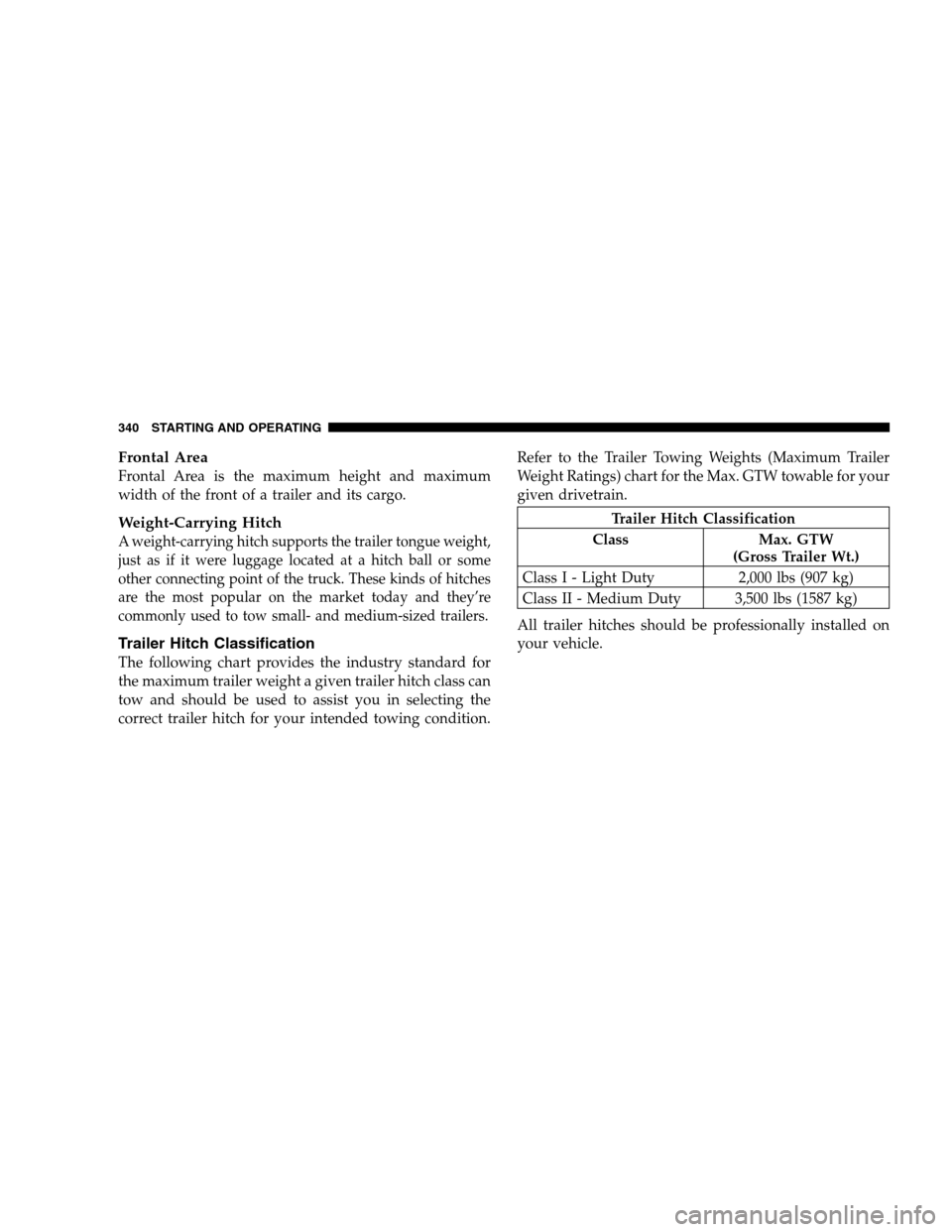
Frontal Area
Frontal Area is the maximum height and maximum
width of the front of a trailer and its cargo.
Weight-Carrying Hitch
A weight-carrying hitch supports the trailer tongue weight,
just as if it were luggage located at a hitch ball or some
other connecting point of the truck. These kinds of hitches
are the most popular on the market today and they’re
commonly used to tow small- and medium-sized trailers.
Trailer Hitch Classification
The following chart provides the industry standard for
the maximum trailer weight a given trailer hitch class can
tow and should be used to assist you in selecting the
correct trailer hitch for your intended towing condition.Refer to the Trailer Towing Weights (Maximum Trailer
Weight Ratings) chart for the Max. GTW towable for your
given drivetrain.
Trailer Hitch Classification
Class Max. GTW
(Gross Trailer Wt.)
ClassI-LightDuty 2,000lbs(907 kg)
Class II - Medium Duty 3,500 lbs (1587 kg)
All trailer hitches should be professionally installed on
your vehicle.
340 STARTING AND OPERATING
Page 343 of 494
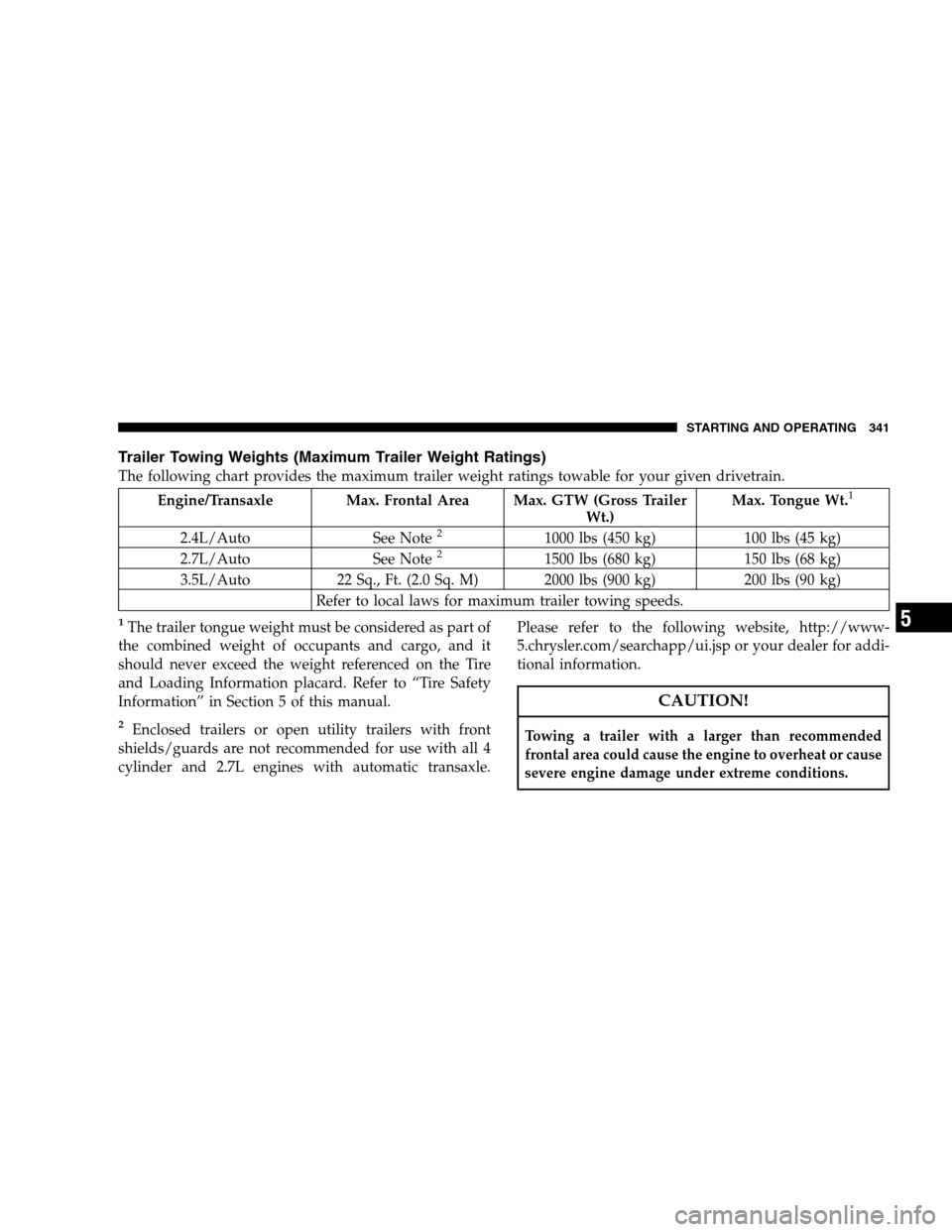
Trailer Towing Weights (Maximum Trailer Weight Ratings)
The following chart provides the maximum trailer weight ratings towable for your given drivetrain.
Engine/Transaxle Max. Frontal Area Max. GTW (Gross Trailer
Wt.)Max. Tongue Wt.1
2.4L/Auto See Note21000 lbs (450 kg) 100 lbs (45 kg)
2.7L/Auto See Note21500 lbs (680 kg) 150 lbs (68 kg)
3.5L/Auto 22 Sq., Ft. (2.0 Sq. M) 2000 lbs (900 kg) 200 lbs (90 kg)
Refer to local laws for maximum trailer towing speeds.
1The trailer tongue weight must be considered as part of
the combined weight of occupants and cargo, and it
should never exceed the weight referenced on the Tire
and Loading Information placard. Refer to “Tire Safety
Information” in Section 5 of this manual.
2Enclosed trailers or open utility trailers with front
shields/guards are not recommended for use with all 4
cylinder and 2.7L engines with automatic transaxle.Please refer to the following website, http://www-
5.chrysler.com/searchapp/ui.jsp or your dealer for addi-
tional information.
CAUTION!
Towing a trailer with a larger than recommended
frontal area could cause the engine to overheat or cause
severe engine damage under extreme conditions.
STARTING AND OPERATING 341
5
Page 345 of 494
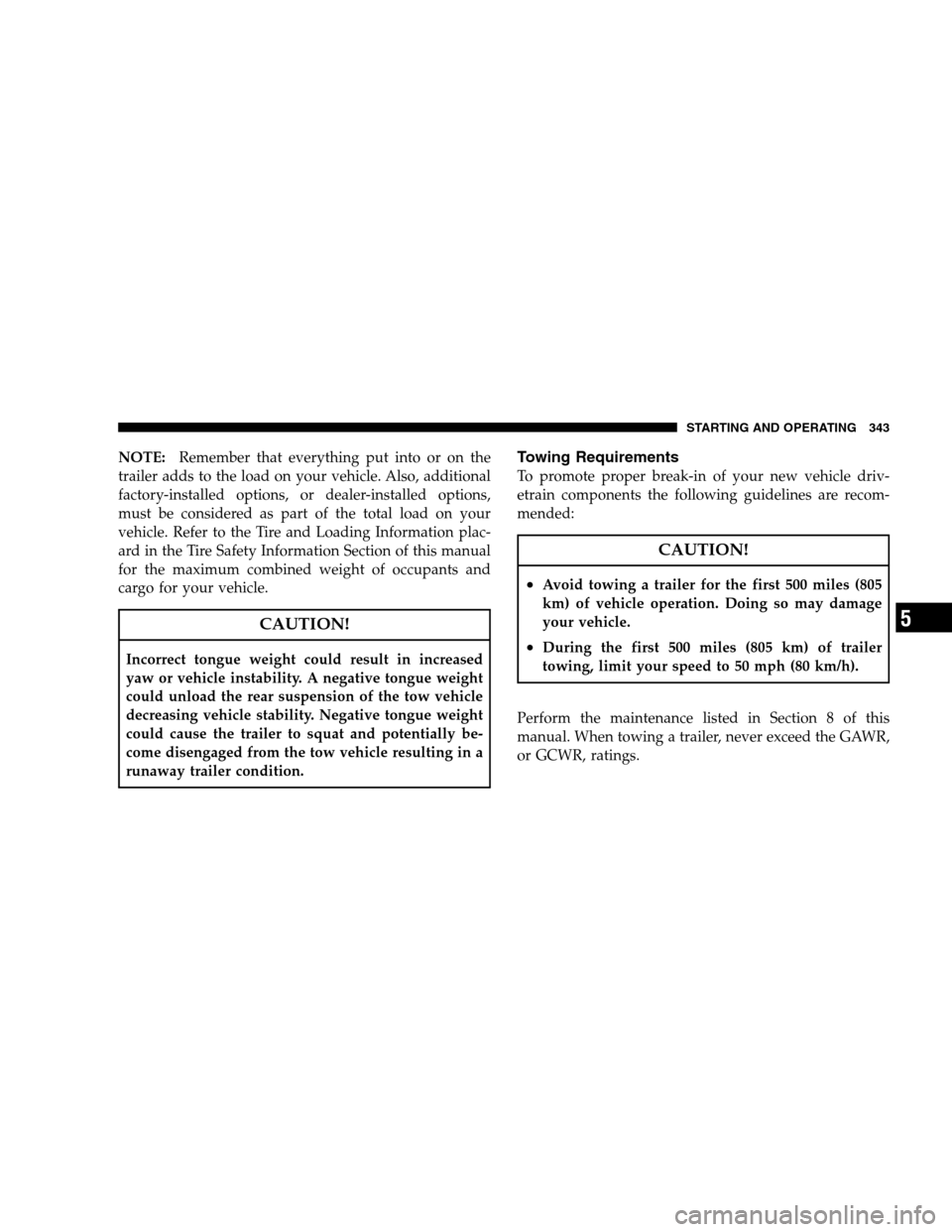
NOTE:Remember that everything put into or on the
trailer adds to the load on your vehicle. Also, additional
factory-installed options, or dealer-installed options,
must be considered as part of the total load on your
vehicle. Refer to the Tire and Loading Information plac-
ard in the Tire Safety Information Section of this manual
for the maximum combined weight of occupants and
cargo for your vehicle.
CAUTION!
Incorrect tongue weight could result in increased
yaw or vehicle instability. A negative tongue weight
could unload the rear suspension of the tow vehicle
decreasing vehicle stability. Negative tongue weight
could cause the trailer to squat and potentially be-
come disengaged from the tow vehicle resulting in a
runaway trailer condition.
Towing Requirements
To promote proper break-in of your new vehicle driv-
etrain components the following guidelines are recom-
mended:
CAUTION!
•Avoid towing a trailer for the first 500 miles (805
km) of vehicle operation. Doing so may damage
your vehicle.
•During the first 500 miles (805 km) of trailer
towing, limit your speed to 50 mph (80 km/h).
Perform the maintenance listed in Section 8 of this
manual. When towing a trailer, never exceed the GAWR,
or GCWR, ratings.
STARTING AND OPERATING 343
5
Page 346 of 494
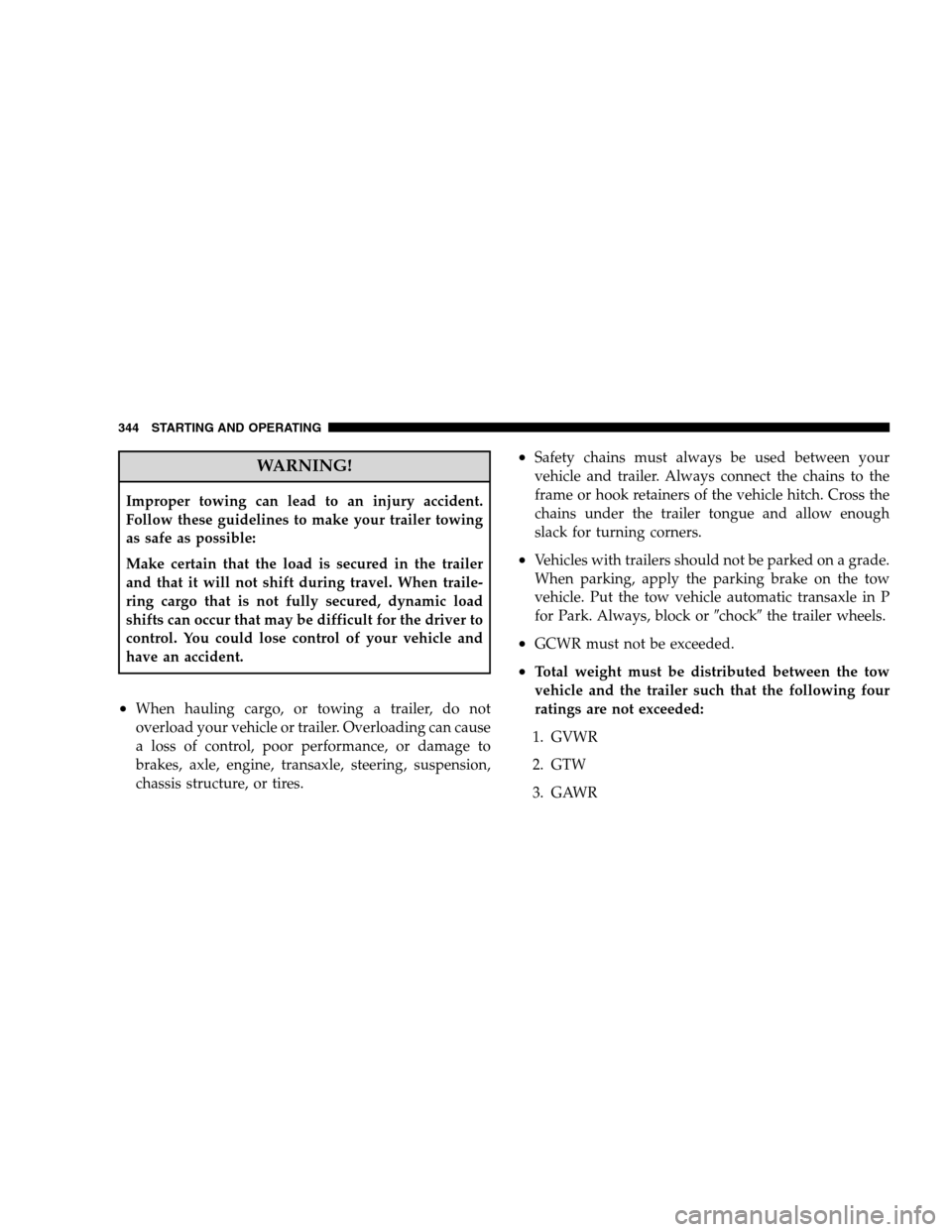
WARNING!
Improper towing can lead to an injury accident.
Follow these guidelines to make your trailer towing
as safe as possible:
Make certain that the load is secured in the trailer
and that it will not shift during travel. When traile-
ring cargo that is not fully secured, dynamic load
shifts can occur that may be difficult for the driver to
control. You could lose control of your vehicle and
have an accident.
•When hauling cargo, or towing a trailer, do not
overload your vehicle or trailer. Overloading can cause
a loss of control, poor performance, or damage to
brakes, axle, engine, transaxle, steering, suspension,
chassis structure, or tires.
•Safety chains must always be used between your
vehicle and trailer. Always connect the chains to the
frame or hook retainers of the vehicle hitch. Cross the
chains under the trailer tongue and allow enough
slack for turning corners.
•Vehicles with trailers should not be parked on a grade.
When parking, apply the parking brake on the tow
vehicle. Put the tow vehicle automatic transaxle in P
for Park. Always, block or�chock�the trailer wheels.
•GCWR must not be exceeded.
•Total weight must be distributed between the tow
vehicle and the trailer such that the following four
ratings are not exceeded:
1. GVWR
2. GTW
3. GAWR
344 STARTING AND OPERATING